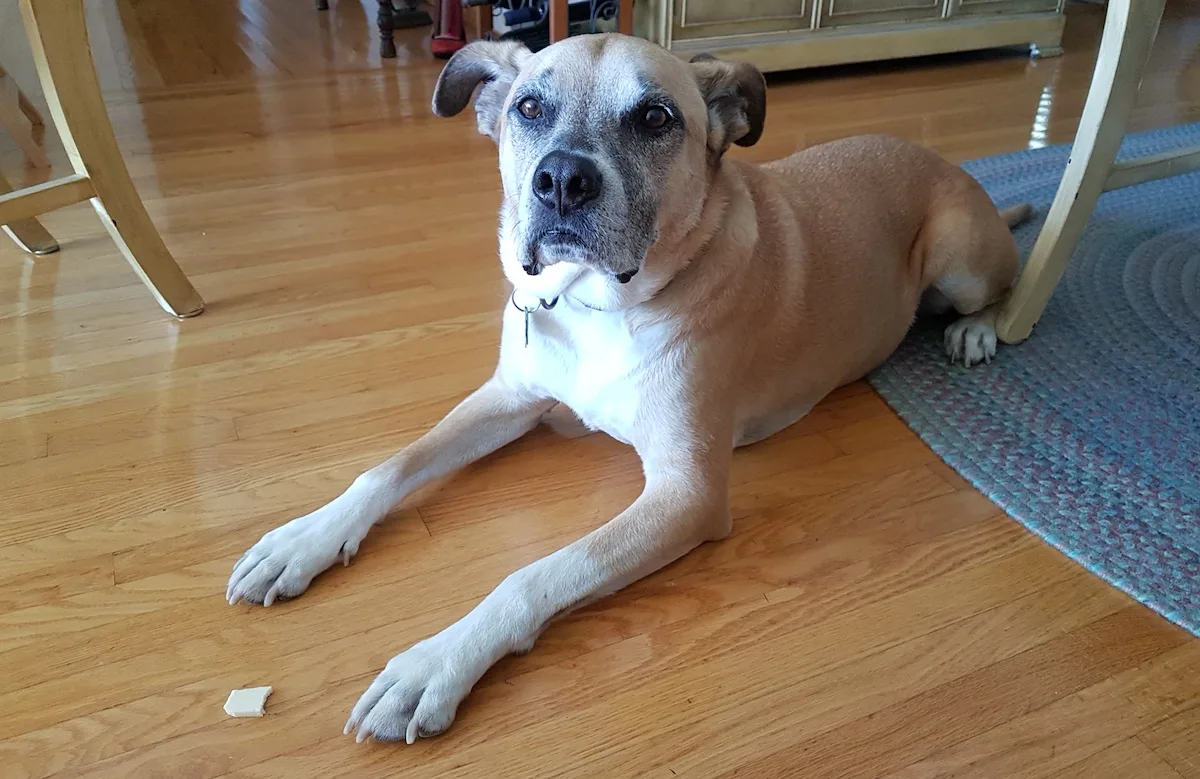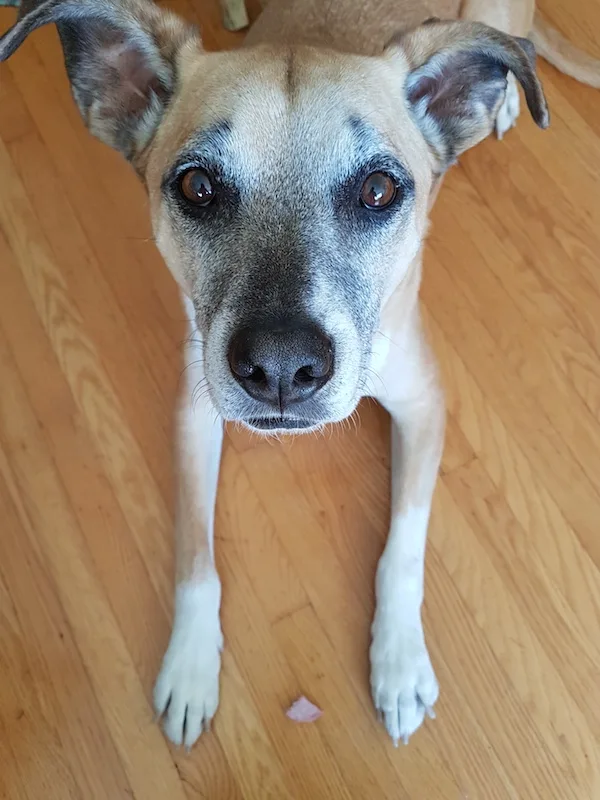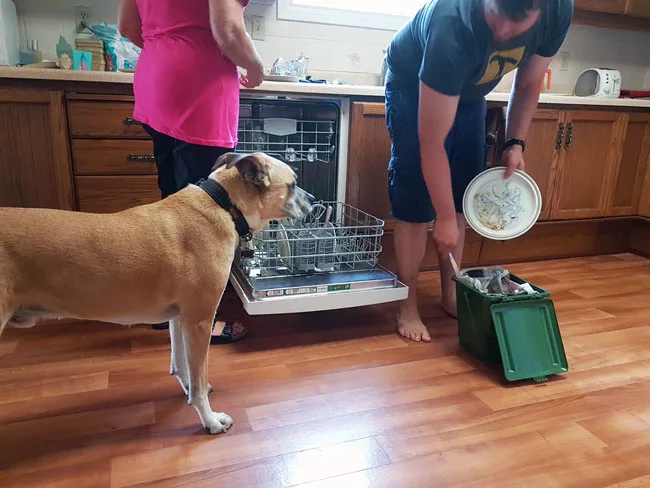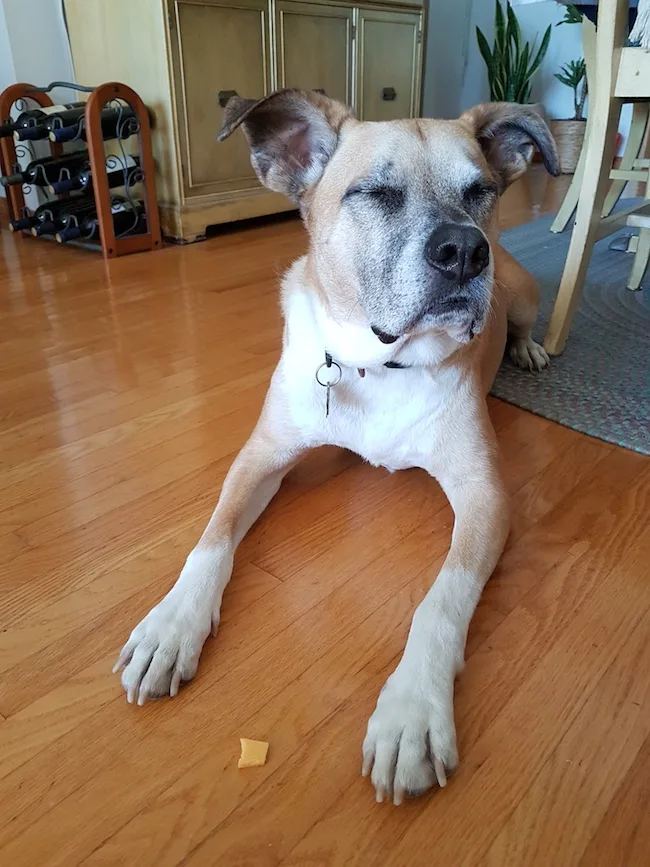It’s always a good idea to refresh our dogs’ training and commands every so often.
With that in mind, I’m going back to an old post of Lindsay’s and revisiting how to teach your dog leave it. In the comments, let us know if there are any other commands you’d like us to re-visit in future posts.
Lindsay defined “leave it” as “do not touch that object.” As in don’t sniff, don’t eat, don’t touch that thing right in front of you. This is different than using “leave it” to mean “leave that other dog alone,” and especially different from “ignore that other dog on the other side of the street.”

In Lindsay’s original post, she went through the steps of teaching “leave it” using high value and lower value treats. I’ve mentioned before that our trainer does not use treats in her training, so our approach to teaching “leave it” was a bit different.
How to teach your dog leave it—what we did
We started with a low value item—a piece of bread—on the ground. We did not give the “leave it” command until our dog moved towards the bread. At the same time as we said the command, we placed our hand over the bread to block our dog.
We used a fairly assertive motion to get the dog’s attention and be clear about our expectations. Successful “leave its” were rewarded with praise and petting.
Unfortunately for Baxter, I misinterpreted his action. He was just coming to say hi to me. He wasn’t interested in the bread. In my attempt to successfully execute the “leave it,” I karate chopped him right on the nose. I apologized—and recognized his excellent “leave it”—with enthusiastic scratches and petting, but for the rest of the lesson, Baxter stayed as far away from the bread as possible.

Two notes about blocking your dog from the treat:
- Be careful about blocking if your dog isn’t actually going for the treat. You don’t want to penalize your dog for good behaviour.
- Be careful about blocking if you have a very food motivated dog. You don’t want to be bit accidentally.
Lindsay’s post details the steps of teaching “leave it” in good detail, so I’m not going to restate them here. However, I want to emphasize one important consideration. When teaching “leave it” it’s usually best to not reward your dog with the original item.
Think about it. You put a piece of super tasty cheese on the ground, tell your dog “leave it” and he executes it perfectly. Then as a reward, you pick up the cheese and give it to him.
Now translate that to the real world.
On your walk, your dog finds a tasty piece of cheese. You tell him leave it and begin to walk on. The dog knows that usually after leave it, he gets the item as a reward. He refuses to walk, waiting for his cheesy goodness. This mixed message can be very confusing for dogs.

The final consideration I want to discuss while we’re thinking about “leave it” is going beyond this command to teach “take it.”
For another trainer I follow “leave it” is assumed for all situations. This means if a bottle of pills falls and spills all over the floor, her dogs know without being told that the pills are forbidden. Likewise, a snack sitting on the coffee table, litter on the sidewalk, animal poop in the backyard or sloppy cutlery in the open dishwasher. They’re all out of bounds, unless the dog is told that he can “take it.”

Admittedly, “take it” may require more training and a very strong foundation of “leave it” is still beneficial.
Whether you teach “leave it” or “take it,” these are both important commands to protect your dog from dangerous hazards and make life together more pleasant.
What are your tips for teaching leave it? What’s your dog’s hardest object to leave?
Do you work on refreshing commands with your dog?
Are there any commands you’d like us to explore in future posts?
Julia Thomson is a blogger at Home on 129 Acres where she writes about her adventures of country living and DIY renovating. She and her family live on a 129-acre farm in Ontario, Canada.

Katie
Tuesday 4th of September 2018
I cannot get my puppy Max to leave anything on the ground alone. He full on eats anything and everything every chance he can get. His favorite sidewalk snack is mulch. I have tried leave it and drop it with him (when I am not fast enough for the "leave it" command). He has a few tricks hes picked up along the way that I cannot seem to break. First, he hoovers up stuff on the ground in lightening speed. He trots along smelling, smelling, then BOOM! Just slurps it up and almost inhales it before I can even react. Second, he knows exactly when I have treats on our walks. When he knows I have them, he scoops up the sidewalk snack, turns and looks at me, and spits it out before I can even give him the drop it command. Then looks at me like "where's my cheese, lady?!" So frustrating! I don't know how to get him to leave stuff alone or drop it short of giving him treats every 5 seconds on our walk (this may have to be the case) or pulling things out of his mouth (which I do not want to do). I feel like I am making no progress with him with regard to eating stuff off of the ground CONSTANTLY.
Julia at Home on 129 Acres
Friday 7th of September 2018
That sounds super frustrating, Katie. I don't have a lot of experience with puppies (Lindsay might be able to weigh in here), but maybe he'll outgrow this compulsion? In the meantime, is there something you can do to shift his focus from looking for the next "treat"? I'm thinking changing your pace, zigzagging, turning around (as in walking back and forth), working on "heel" or "touch" (or even "sit" or "down" every few steps)? Admittedly these actions do not make a relaxing walk, but they help him to pay attention to you (as he should) rather than everything else around him. Good luck to you.
Amanda
Wednesday 22nd of August 2018
Hi! I just love all your help and suggestions. I have a topic Id like a little advice on. My sweet Bentley is a tiny Yorkie-Poo, he's only 3 lbs. , although he doesn't know that (Big Dog Syndrome is what I call it, LOL). We've had him from birth and we just celebrated his 1st birthday so hes still a baby. Our issue is he is very territorial...like when someone new, or even family sometimes, walks thru our door he goes crazy barking and in full attack mode at there ankles, growling, jumping, even nipping. But not just at home now, I cant take him out in public without him fully tripping out to the point of him almost hurting himself. I have to pick him up and rush him away. I am very concerned, hes so sweet and loving but we want him to love people as much as we do, they will just keep coming over, LOL. Help!
Lindsay Stordahl
Wednesday 22nd of August 2018
Great topic idea, and such a common problem.
Andrea
Tuesday 21st of August 2018
I would like training on my treewalker coon/ shepherd mix to stop chewing on everything from my underwear,couch and everything she can get to
Lindsay Stordahl
Wednesday 22nd of August 2018
Oh man, many people can relate to that! How old is your dog?
Kathryn
Tuesday 21st of August 2018
How can I get our 1 year old French Bulldog to get in his crate at night without going ballistic trying to attack you when you close the door and put a sheet over the crate. We have been doing this since we got him at 4 months old. It is getting harder and harder to get him in the crate... I try to bribe him with food by throwing it in the back of the crate, but he has caught on to this and won't go in the crate for at least 20 minutes as long as I am not too close to it. He has chewed our furniture and still occasionally peed in the house so we don't want him to roam free... Also we have a play pen that we put him in sometimes, but he cries after he wakes up after a few hours and wants to just get out. He stays asleep longer in the crate.
Lindsay Stordahl
Tuesday 21st of August 2018
Here was my response to another woman with a similar issue about aggression when going in the kennel. I was basically suggesting she look for ways to change up the routine a bit so the dog's usual "triggers" are not there. For example, move the crate to another room or get a different crate and change up the routine before going in the crate. You might want to also try making a game of tossing treats in the kennel throughout the day randomly as a fun game for him. Or try giving him a special treat at night in his kennel such as a Kong stuffed with peanut butter (and frozen).
Here's what I said in my email to her:
With the kennel issue, you might want to try using a pet or baby gate and keeping him in a small area like a bathroom. Or, you might want to try using a different type of crate, like a wire one and put it in a different room. Make it a fun game to go in this new kennel with lots of treats and positive energy. Basically, you are changing things up so his usual "triggers" are not there, whatever those may be.
My weim will turn and nip at me when I close his kennel door as well. It seems to be out of frustration, but much more mild and less serious than your case. With him, I use high valued treats and tell him "kennel" and then "down." When he's lying down, I toss him the treats and then close the door. Then I give him another treat if he is calm and not rushing the door. This helped very much. But he was not biting hard, more of a hard play bite as a protest.
Lindsay Stordahl
Tuesday 21st of August 2018
Good topic idea, Kathryn. Sorry you are dealing with this. Someone else emailed me with the same issue. I'm going to look for my response and share it with you. I'll paste it here. I had a similar issue with my weimaraner dog but not as bad as yours.
Jeri
Tuesday 21st of August 2018
You asked for training topics. I REALLY need to have an "outdoor" dog - one who's job is to keep the many other 4-legged intruders away from my home & yard. I would prefer to adopt an older dog (not a puppy) - and need him to stay on our property - which is waaayyy to large to fence or to use invisible fence. Nearly all farms in our area have a resident "farm dog" that stays "home". So some tips on training them to stay "home" would be appreciated!
Lindsay Stordahl
Tuesday 21st of August 2018
That is a good idea, thank you Jeri. I have family who live on a ranch and their ranch dogs always know to stay home.